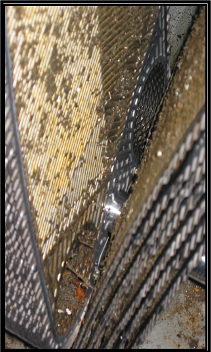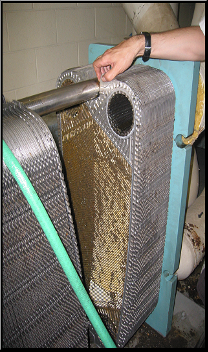 When should you choose to use a gasketed plate, brazed plate, or shell and tube heat exchanger? Often in HVAC, plumbing, or industrial systems any one of them could be used. How does the engineer decide which is best for their client? Today, the R. L. Deppmann Monday Morning Minutes looks at varying flow rates and application thoughts.
When should you choose to use a gasketed plate, brazed plate, or shell and tube heat exchanger? Often in HVAC, plumbing, or industrial systems any one of them could be used. How does the engineer decide which is best for their client? Today, the R. L. Deppmann Monday Morning Minutes looks at varying flow rates and application thoughts.
In part 3 of this series, we looked at the effect of temperature on your choice of style of heat exchanger to apply in heating, cooling, plumbing, and process applications. We offered three application tips for selection of heat exchangers. Today, we look at the effect of velocity on your selection.
Plate Heat Exchangers and Flow Rate
In part two of this series, we explained the need for high velocities in plate exchangers to achieve the large “U” values. We also want that high velocity to keep scouring the channels to avoid clogging due to water quality issues such as calcium buildup.
A plate heat exchanger is normally a single pass counterflow device. The hot side and cold side on the exchanger look the same. They have the same connections, the same flow passage diameter, and the same length of the flow paths. When you have different flow rates on the two sides, the model is sized on the larger flow rate.
Shell and Tube Heat Exchangers and Flow Rate
In part 1 of the series, we looked at shell and tube heat exchangers. We would consider this style if there were no temperature cross and the approach is not too close. The shell and tube has a big advantage with widely different flow rates on the two sides of the exchanger. The tube side can be designed with single, two, four, or even six pass models. The number of tube side passes is determined by the flow rate and velocity limitation per pass.
As an example, let’s assume a velocity limit on any tube side pass of 7 FPS (feet per second). If the surface area required would be in a minimum size of a 10” diameter heat exchanger, here is what changing the number of passes can do. Assume the BTUH load remains the same but ΔT changes. Let’s assume the flow rate on the shell side remains 600 GPM for all four selections.
| Number of Passes | Tube Flow Rate for Max. Velocity | Length to Achieve Required Area |
| 1 | 600 GPM | 3’ |
| 2 | 300 GPM | 4’ |
| 4 | 150 GPM | 4’ |
| 6 | 100 GPM | 5’ |
In the single pass selection, the flow rate is 600 GPM on each side. In the 6-pass selection the shell side remained at 600 GPM, but the tube side was now 100 GPM. In the 6-pass selection the tube side flow rate is 1/6 of the shell side yet both have the maximum velocity for great heat transfer.
Gasketed and Brazed Plate Heat Exchangers and Flow Rate
In a single pass counterflow plate style heat exchanger, things are different. When both sides are 600 GPM, the velocity on both sides is the same. The heat exchanger will be sized with as high a velocity that the pressure drop limitation will allow. Now what happens if one side is 600 GPM, and the other is 100 GPM? The plate size will be determined by the higher flow rate. The 100 GPM side will be about 1/6th of the velocity the plates want to see. This will reduce the pressure drop on that side but may also cause an issue.
Velocity helps minimize fouling in plate heat exchangers by scouring the channels. If the velocity is significantly lower on one side, fouling may be an issue. What is significantly lower? There is no published recommendation on this. Here is my thought. In building applications, the plate heat exchangers end up with velocities in the 10 to 15 FPS range due to pressure drop limitations. Obviously, 10 FPS will scour much better than 5 FPS. Try to avoid flow differences greater than 4:1. At 2-1/2 to 3 FPS there is a much greater chance for deposits. This is particularly important in open systems such as cooling tower and domestic water applications.
Fouled plate heat exchanger. Photo provided by James M. Pleasants Company.
Application Suggestion Four*: When using a plate heat exchanger, try to keep the flow rates equal or close to each other on both the hot and cold sides. If possible, avoid flow rate differences where one fluid GPM is 25% or less than the other.
* Applications 1 through 3 are in Part 3 of this series
Heat Exchangers and Variable Flow Rate
Many systems in heating, cooling, and plumbing have variable flow rates. If the heat exchanger is subjected to severely reduced flow rates, there may be a concern about lack of turbulent flow. This will reduce the heat transfer to a fraction of what the system may need.
Shell and tube heat exchangers with water have a lot of room to reduce flow rate before reaching laminar flow. Shell and tube heat exchangers with glycol are not as forgiving.
Plate heat exchangers can take extremely lower velocities as a percentage of the typical design velocity. It is always a good idea to provide the expected minimum flow rate when discussing the selection of heat exchangers. The representative will be able to comment so the engineer can match the system pumping expectations with the heat exchanger output expectations. This is one of those times when a discussion trumps a computer selection.
Here are a few previous blogs on Velocity Limits in Heat Exchangers:
- Part 1: Maximum Velocities in Heat Exchangers
- Part 2: Minimum Velocity in Heat Exchangers
- Part 3: Minimum Velocity for Heat Exchangers with Glycol
- Part 4: Velocity Limits in Gasketed Plate Heat Exchangers
Plumbing Systems
Watch out for variable flow domestic hot water applications in plate heat exchangers. Particularly in locations with hard water. Imagine if you select a heat exchanger to heat domestic water with a design flow rate of 1/3 of the flow rate on the hot water side of the exchanger. We know most of time the load on the domestic water side will use fraction of the design flow rate. This could be a maintenance headache for your client.
The concern for velocity in domestic water and cooling towers was the reason for the primary secondary pumps in the article Hot Water Heater Decarbonization: Using Condenser Water to Pre-Heat the Incoming Cold-Water .
Application Suggestion Five: When using plate heat exchangers in domestic water applications, use a circulation pump to maintain velocity through the heat exchanger.
Hopefully, this series will help you make a better decision when deciding between types of heat exchangers in your heating, cooling, and plumbing applications.
Part 1: Heat Exchanger Types and Where to Use Them: Shell & Tube
Part 2: Heat Exchanger Types and Where to Use Them: Plate Style
Part 3: Heat Exchanger Types and Where to Use Them: Close Temperature Applications



